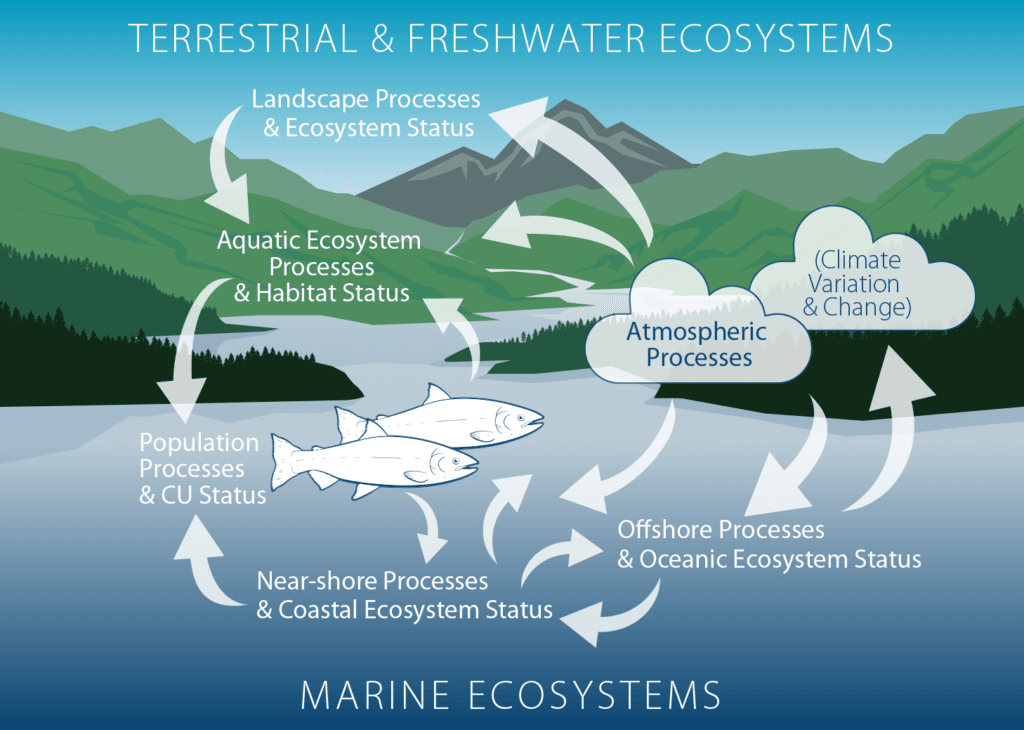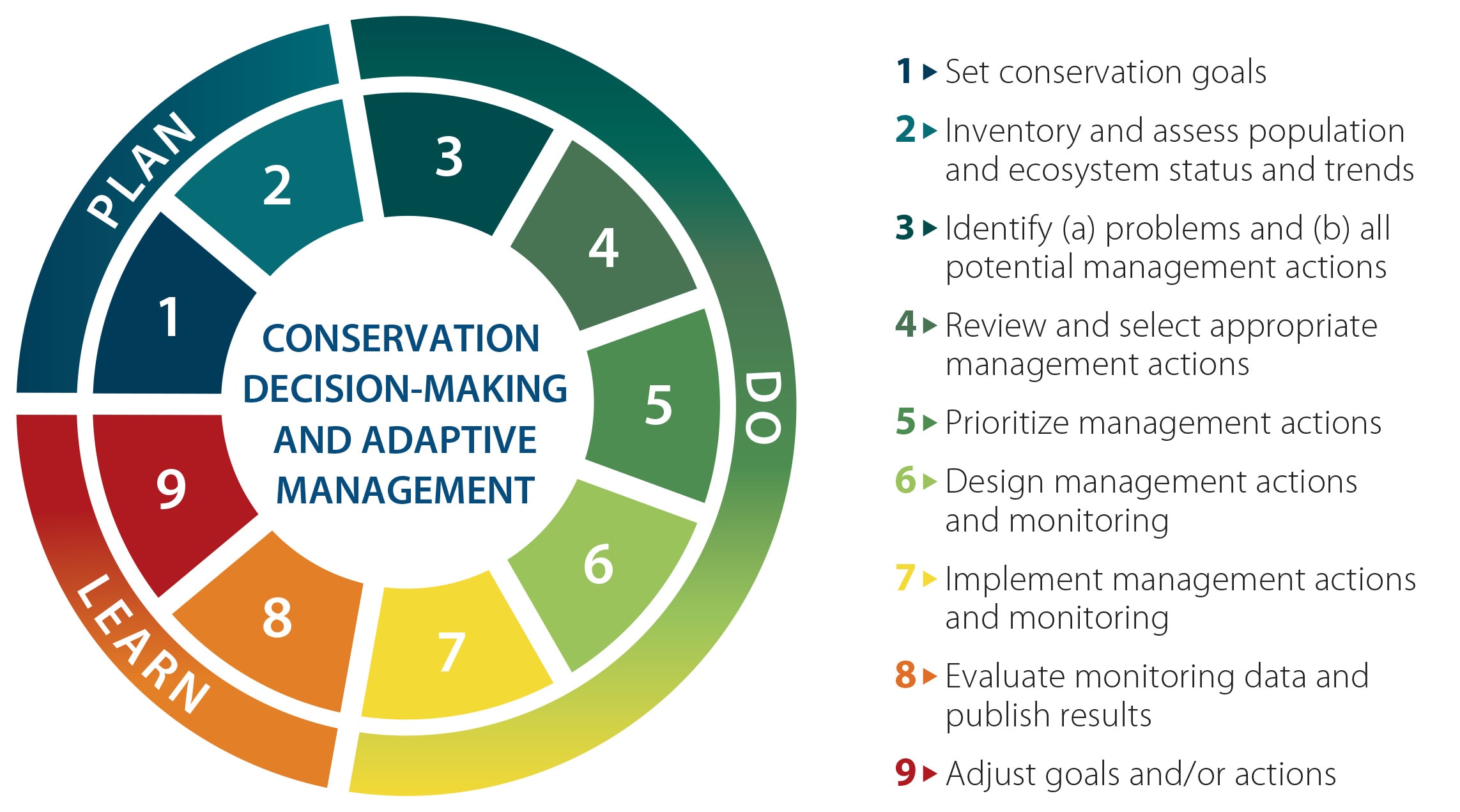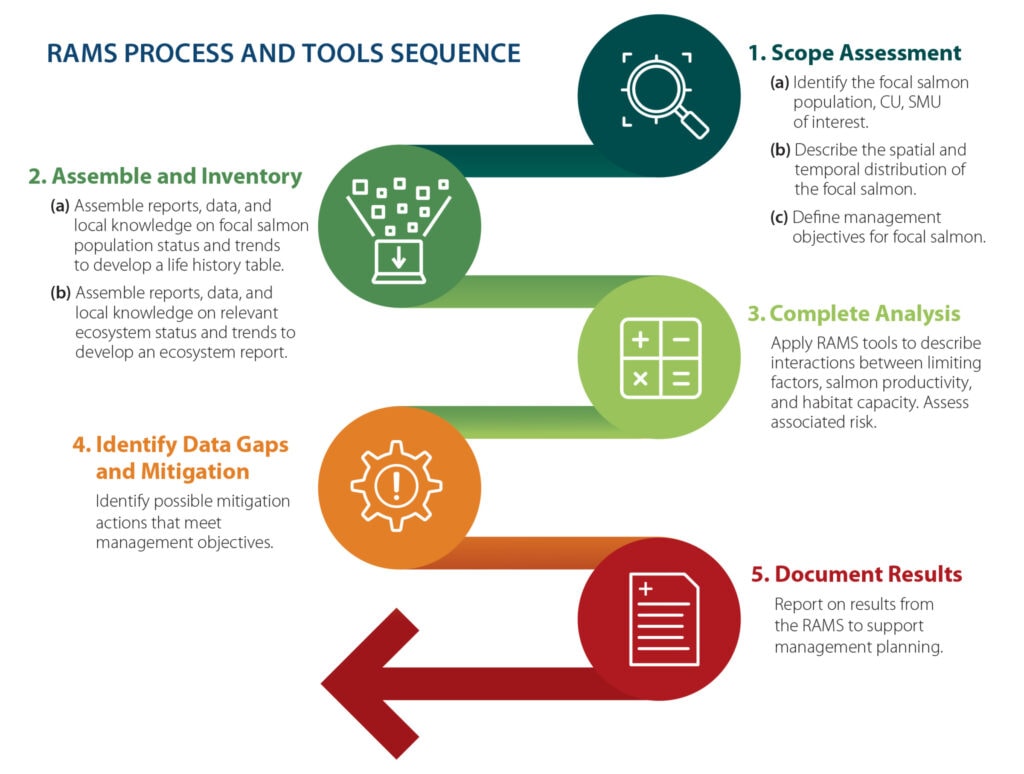Risk Assessment Method for Salmon
Background
The Risk Assessment Method for Salmon (RAMS) was originally developed to provide a series of tools that could be used to comprehensively assess a broad selection of threats or limiting factors affecting Pacific salmon stocks. More specifically, stocks of conservation concern in BC and the Yukon due to low abundance, limited empirical data, and/or high uncertainty regarding the impacts of threats.
Initially, RAMS was designed to support the Wild Salmon Policy (DFO 2005). Over time, it has been adapted to support Recovery Potential Assessments for stocks being considered for listing under the Canadian Species at Risk Act (DFO 2007, DFO 2014a,b). More recently, it has also been adapted for supporting Rebuilding Plans for stocks prescribed to the Fish Stock Provisions of the Fisheries Act (DFO 2019a, DFO 2022) and efforts to support integrated assessment for Pacific salmon.

What is RAMS?
RAMS is a set of processes (e.g. limiting factor analysis, risk ranking) and tools (e.g. maps, ecosystem status report, simple life stage tables) applied in a series of steps. Application of RAMS is generally done in conjunction with an expert workshop(s) to:
- Assess science, local knowledge, and expert opinion on the state of a salmon population, CU, or SMU and their associated habitats.
- Identify natural and human-origin factors most likely to limit production of a group of salmon (i.e., populations, CUs, or SMUs).
- Identify options or actions to overcome the factors limiting salmon production.
- Create a retrievable record that enables verification of origin states and future changes to RAMS assessment results and recommendations.
Goals
RAMS has been designed to provide a structured process to:
- Scope the scale of the recovery, restoration, or rebuilding assessment;
- Assemble relevant existing salmon population and ecosystem information;
- Systematically assess and prioritize a comprehensive list of factors limiting current and future productive capacity of salmon under climate change;
- Identify key knowledge gaps to direct scientific research and/or monitoring and describe potential mitigation options; and
- Monitor, review, and re-evaluate options for recovery and rebuilding under an adaptive management framework.

This methodology has been implemented for a variety of salmon populations, CUs, and SMUs in the Pacific Region since development. Each of them applied the RAMS protocols with adjustments to account for locally unique features of the population being assessed and variation in the available data and relevant analyses. Over time, the methods have been refined for consistent regional implementation. Also, through applying the RAMS framework and other risk assessment methodologies such as the ERAEF to real-world fisheries examples, practitioners have acquired best practices and lessons learned that can facilitate improved future implementation of the frameworks.
Interactive Tool
The tool below provides an interactive map displaying the habitat status information and RAMS processes conducted in British Columbia to date. Each point in the map contains habitat status or RAMS information about a specific unit of assessment and/or watershed, as well as links to all the documents currently available.
To get started, pan o zoom to your area of interest. Clicking on the points in the map will display specific information about each unit of assessment. It will also display a "Download Materials" button that links to all the materials available for that unit of assessment. Click this widget ![]() to display the legend information of the map. This widget
to display the legend information of the map. This widget ![]() displays all the available layers in the map and allows for layer activation/deactivation.
displays all the available layers in the map and allows for layer activation/deactivation.
Glossary:
| Watershed | The land on which water falls from the atmosphere and moves down-slope to other locations. Each watershed is a catchment area divided from the next watershed by topographic features, the most noticeable of which are ridge tops. Watersheds are the natural landscape units from which hierarchical drainage networks are formed. |
| Conservation Unit (CU) | Groups of biologically and genetically similar populations sufficiently isolated from other groups that, if extirpated, will be unlikely to naturally recolonize within an acceptable time frame, such as a human lifetime. |
| Stock Management Unit (SMU) | Group of one or more CUs that are managed together with the objective of achieving a "joint status", meaning harvest control rules would apply to the aggregate, at least in a coarse sense. |
| Designatable Unit (DU) | Unit of Canadian Biodiversity that is discrete and evolutionarily significant, where discrete means that there is currently very little transmission of heritable (cultural or genetic) information from other such units, and evolutionarily significant means that the unit harbours heritable adaptive traits or an evolutionary history not found elsewhere in Canada. |
| Management Area | Division of Canadian fisheries waters that includes the portion of any stream that flows into that division and that is seaward of the mean high water mark near the mouth of that stream (Pacific Fishery Management Area Regulations, 2007). |
Moving Forward
RAMS has been designed to be highly flexible in dealing with salmon as a complex system of life history stages, populations, CUs, SMUs, and associated habitats. All of these system elements are subjected to natural- and human-origin sources of change that shape potential limiting factors operating on a group of salmon at a variety of spatial and temporal scales. The RAMS process steps and associated tools for their implementation would appear to offer a standard framework within which to address certain requirements of Canada’s Fisheries Act in relation to Pacific salmon.
References
DFO. 2014a. Guidance for the completion of Recovery Potential Assessments (RPA) for Aquatic Species at Risk. Fisheries and Oceans Canada.
DFO. 2014b. Guidance on assessing threats, ecological risk and ecological impacts for Species at Risk. Canadian Science Advisory Secretariat 2014/013.
DFO. 2018. Wild Salmon Policy 2018-2022 Implementation Plan.
Roni, P., & Beechie, T., editors. 2013. Stream and Watershed Restoration: A Guide to Restoring Riverine Processes and Habitats. John Wiley & Sons, Ltd.




